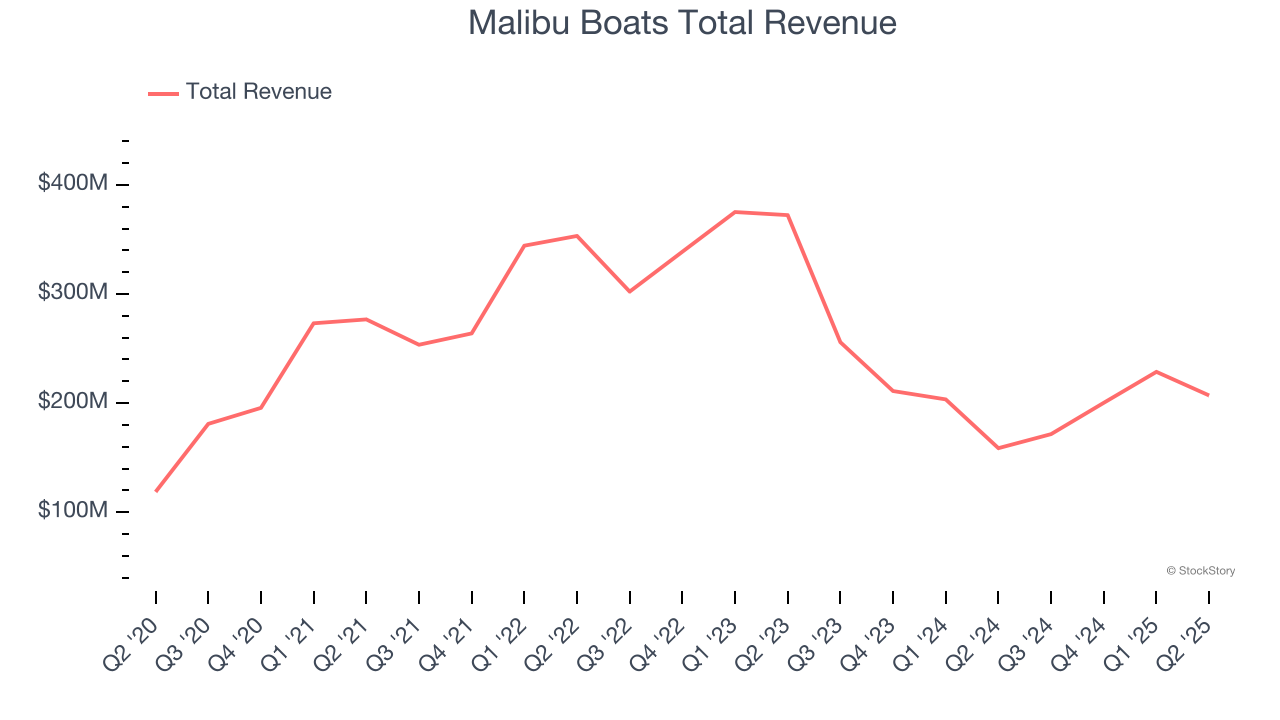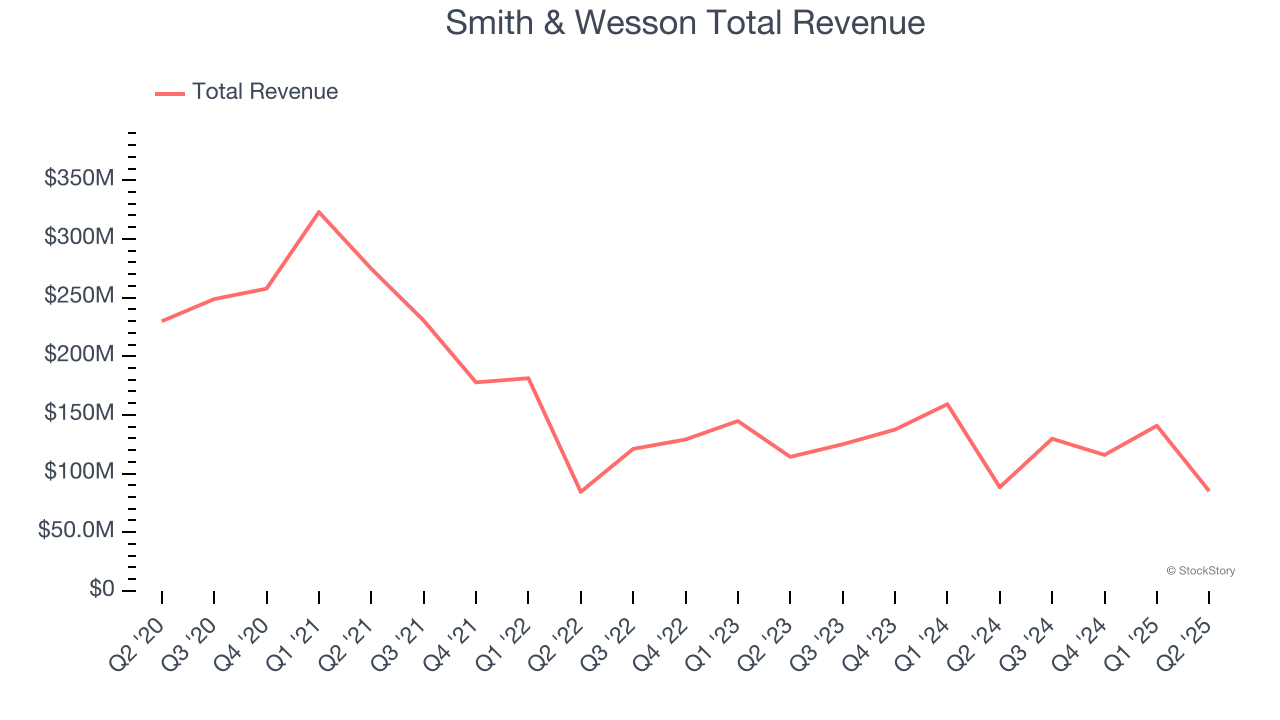
Quarterly earnings results are a good time to check in on a company’s progress, especially compared to its peers in the same sector. Today we are looking at Malibu Boats (NASDAQ: MBUU) and the best and worst performers in the leisure products industry.
Leisure products cover a wide range of goods in the consumer discretionary sector. Maintaining a strong brand is key to success, and those who differentiate themselves will enjoy customer loyalty and pricing power while those who don’t may find themselves in precarious positions due to the non-essential nature of their offerings.
The 12 leisure products stocks we track reported a mixed Q2. As a group, revenues beat analysts’ consensus estimates by 3.5% while next quarter’s revenue guidance was 0.9% below.
In light of this news, share prices of the companies have held steady as they are up 3.5% on average since the latest earnings results.
Malibu Boats (NASDAQ: MBUU)
Founded in California in 1982, Malibu Boats (NASDAQ: MBUU) is a manufacturer of high-performance sports boats and luxury watercrafts.
Malibu Boats reported revenues of $207 million, up 30.4% year on year. This print exceeded analysts’ expectations by 5.4%. Despite the top-line beat, it was still a slower quarter for the company with a significant miss of analysts’ EPS and adjusted operating income estimates.

Unsurprisingly, the stock is down 24.3% since reporting and currently trades at $29.96.
Read our full report on Malibu Boats here, it’s free for active Edge members.
Best Q2: Smith & Wesson (NASDAQ: SWBI)
With a history dating back to 1852, Smith & Wesson (NASDAQ: SWBI) is a firearms manufacturer known for its handguns and rifles.
Smith & Wesson reported revenues of $85.08 million, down 3.7% year on year, outperforming analysts’ expectations by 7.4%. The business had an incredible quarter with a beat of analysts’ EPS and EBITDA estimates.

The market seems happy with the results as the stock is up 24.8% since reporting. It currently trades at $10.25.
Is now the time to buy Smith & Wesson? Access our full analysis of the earnings results here, it’s free for active Edge members.
Weakest Q2: American Outdoor Brands (NASDAQ: AOUT)
Spun off from Smith and Wesson in 2020, American Outdoor Brands (NASDAQ: AOUT) is an outdoor and recreational products company that offers outdoor and shooting sports products but does not sell firearms themselves.
American Outdoor Brands reported revenues of $29.7 million, down 28.7% year on year, falling short of analysts’ expectations by 17%. It was a disappointing quarter as it posted a significant miss of analysts’ revenue and EBITDA estimates.
American Outdoor Brands delivered the weakest performance against analyst estimates and slowest revenue growth in the group. As expected, the stock is down 21.6% since the results and currently trades at $8.15.
Read our full analysis of American Outdoor Brands’s results here.
Polaris (NYSE: PII)
Founded in 1954, Polaris (NYSE: PII) designs and manufactures high-performance off-road vehicles, snowmobiles, and motorcycles.
Polaris reported revenues of $1.88 billion, down 5.6% year on year. This print beat analysts’ expectations by 9.2%. Overall, it was an exceptional quarter as it also produced a beat of analysts’ EPS estimates and a solid beat of analysts’ revenue estimates.
The stock is up 26.7% since reporting and currently trades at $62.63.
Read our full, actionable report on Polaris here, it’s free for active Edge members.
YETI (NYSE: YETI)
Founded by two brothers from Texas, YETI (NYSE: YETI) specializes in durable outdoor goods including coolers, drinkware, and other gear tailored to adventure enthusiasts.
YETI reported revenues of $445.9 million, down 3.8% year on year. This result lagged analysts' expectations by 3.7%. Aside from that, it was a very strong quarter as it put up full-year EPS guidance exceeding analysts’ expectations and a solid beat of analysts’ adjusted operating income estimates.
The stock is down 9% since reporting and currently trades at $33.17.
Read our full, actionable report on YETI here, it’s free for active Edge members.
Market Update
As a result of the Fed’s rate hikes in 2022 and 2023, inflation has come down from frothy levels post-pandemic. The general rise in the price of goods and services is trending towards the Fed’s 2% goal as of late, which is good news. The higher rates that fought inflation also didn't slow economic activity enough to catalyze a recession. So far, soft landing. This, combined with recent rate cuts (half a percent in September 2024 and a quarter percent in November 2024) have led to strong stock market performance in 2024. The icing on the cake for 2024 returns was Donald Trump’s victory in the U.S. Presidential Election in early November, sending major indices to all-time highs in the week following the election. Still, debates around the health of the economy and the impact of potential tariffs and corporate tax cuts remain, leaving much uncertainty around 2025.
Want to invest in winners with rock-solid fundamentals? Check out our Top 5 Growth Stocks and add them to your watchlist. These companies are poised for growth regardless of the political or macroeconomic climate.
StockStory is growing and hiring equity analyst and marketing roles. Are you a 0 to 1 builder passionate about the markets and AI? See the open roles here.






